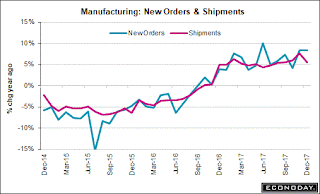Popular Economics Weekly
Stock indexes had the largest one-day drop in history today; what happened? The quick answer is that too much money is chasing too few stocks, believe it or not. The record low interest rates—the 10-year treasury yield just dropped back to 2.75 percent from 2.85 percent before Friday’s selloff—is an indication of the huge cash hoard held by corporations and Wall Street from the successive Quantitative Easing programs by Central Banks that have kept interest rates at record lows.
This is while a Credit Suisse report released last March titled “The Incredible Shrinking Universe of U.S. Stocks,” says between 1996 and 2016, the number of publicly-listed stocks in the U.S. fell by roughly 50 percent — from more than 7,300 to fewer than 3,600 — while rising about 50 percent in other developed nations.
Why do corporations and their Republican lobbyists keep pushing for lower taxes, as I said in an earlier column? They say it will create more jobs. But, alas, that isn’t shown by the record. An excellent New York Times Op-ed by Sarah Anderson at the Institute for Policy Studies points out that many corporations create very few jobs with those profits.
She reported on 92 public-held American corporations between 2008-15 that pay less than 20 percent in taxes. They had a median job growth rate of 1 percent vs. 6 percent for all private sector corporations during that time. And 48 of those companies actually cut 438,000 jobs, while their chief executives’ pay last year averaged nearly $15 million, compared with the $13 million average for all S&P 500 companies.
This should tell us who doesn’t use their profits to increase productivity and growth of their markets; as well as where corporate profits are spent; on stock buybacks that have reduced the number of outstanding publicly listed shares to enhance stockholder returns and CEO paychecks.
It means huge swings in stock prices from too much money chasing too few stocks, should traders panic; which is what they did today and Friday. Yet the panic selling had no underlying reason. Factory orders and the service sector economy is growing even faster than last year while the unemployment rate is still stuck at 4.1 percent and maybe going lower as fewer unemployed workers are even available to fill jobs.
The year-on-year growth for durable orders in the factory sector which has been sloping higher, is now 11.5 percent in December from 8.7 percent in November. This a sign that manufacturing growth is still trending higher, while the ISM non-manufacturing index is at an almost all-time high of 59; which means 59 percent of those surveyed see increased growth in the service sector.
The ISM non-manufacturing sample is also reporting some of the very best conditions in the 20-year history of this series, reports Econoday and the ISM. New orders are arguably more important than any composite result and the reading, at 62.7, is back at last year's peak. Employment is a special standout, up more than 5 points to a very rare plus 60 score of 61.6 which is by the far the best of the post-2008 expansion.
So what to make of the 'yuge' selloff? Some traders are saying it was a series of electronic trading “glitches” that sent prices plunging for no economic reason, and stock prices fall below their intrinsic valuations. Algorithms were at fault on selling billions of shares on the click of a button that had been pre-programmed to sell when prices dropped to a certain level, while other algorithms were programmed not to buy while stocks continued to fall.
It meant computers were chasing each other’s tails; as if they had them. That’s what happens when algorithms rule over common sense, and traders lose their common sense.
Harlan Green © 2018
Follow Harlan Green on Twitter: https://twitter.com/HarlanGreen


No comments:
Post a Comment